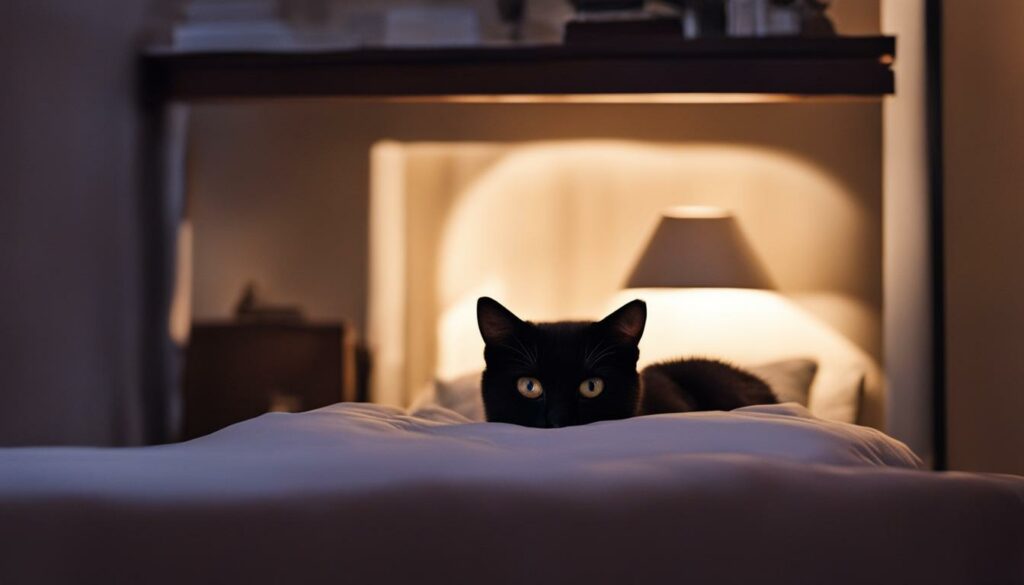As a cat parent, you may have noticed that your feline friend loves hiding under the bed. While this behavior may seem concerning at first, it’s important to understand that it’s completely normal for cats. In fact, hiding is an instinctual behavior for them, providing them with a sense of safety and security.
Cats hide under the bed for various reasons. Changes in their environment, such as a new piece of furniture or a new family member, can cause them to seek out hiding spots. Overstimulation from loud noises, children, or household visitors can also prompt cats to retreat to a quiet place. Fear, discomfort, and illness can also lead to hiding behavior as cats instinctively hide signs of weakness or illness to avoid attention from predators.
While cat hiding under the bed is usually not a cause for concern, there are situations where it may indicate an underlying issue. Sudden changes in hiding behavior, prolonged hiding periods, or hiding accompanied by other symptoms like lethargy, loss of appetite, vomiting, or bathroom accidents should be taken seriously. If you notice these signs, it’s important to consult a veterinarian for further evaluation.
Key Takeaways:
- Hiding under the bed is a normal behavior for cats and provides them with a sense of safety and security.
- Cats hide for various reasons including changes in their environment, overstimulation, fear, discomfort, and illness.
- While hiding is usually not a cause for concern, sudden changes or accompanying symptoms may indicate an underlying issue.
- Consulting a veterinarian is recommended if you have concerns about your cat’s hiding behavior.
- Understanding and addressing your cat’s hiding behavior is crucial for their overall well-being.
Is Hiding Normal for Cats?
Hiding is completely normal behavior for cats. It provides them with a sense of safety, comfort, and security. Well-adjusted cats often seek out hiding spots as a way to relax and nap. Hiding places offer warmth, quiet, and a vantage point to observe their surroundings. Cats may have a favorite hiding spot or establish a pattern of hiding in certain areas, such as near a water heater or clothes dryer in colder months.
Patterns in Hiding Behavior
Cats may exhibit patterns in their hiding behavior. Seasonal factors, home environment, and individual preferences can influence when and where a cat chooses to hide. During winter, cats may seek out warm places like near a water heater or dryer. Cats are generally more active during dawn and dusk, so they may choose to hide during other parts of the day. Cats may also have specific hiding spots for lounging and other spots for escaping. Being observant of these patterns can help cat owners understand their cats’ behaviors.
“Cats find comfort in hiding spots that provide warmth, darkness, and a sense of safety.”
| Reasons for Hiding | Examples |
|---|---|
| Change in the household | New furniture, new family member |
| Overstimulation | Loud noises, children, household visitors |
| Fear | Potential threats, unfamiliar environments |
| Discomfort | Illness, pain |
Cats have both predator and prey instincts, which drive their need to hide. In the wild, cats hide to sneak up on prey or to avoid being preyed upon by larger animals. This instinctual behavior is rooted in their survival skills. Cats find comfort in hiding spots that provide warmth, darkness, and a sense of safety. Understanding and accepting their instinctual need to hide can help cat owners create a conducive environment for their feline companions.
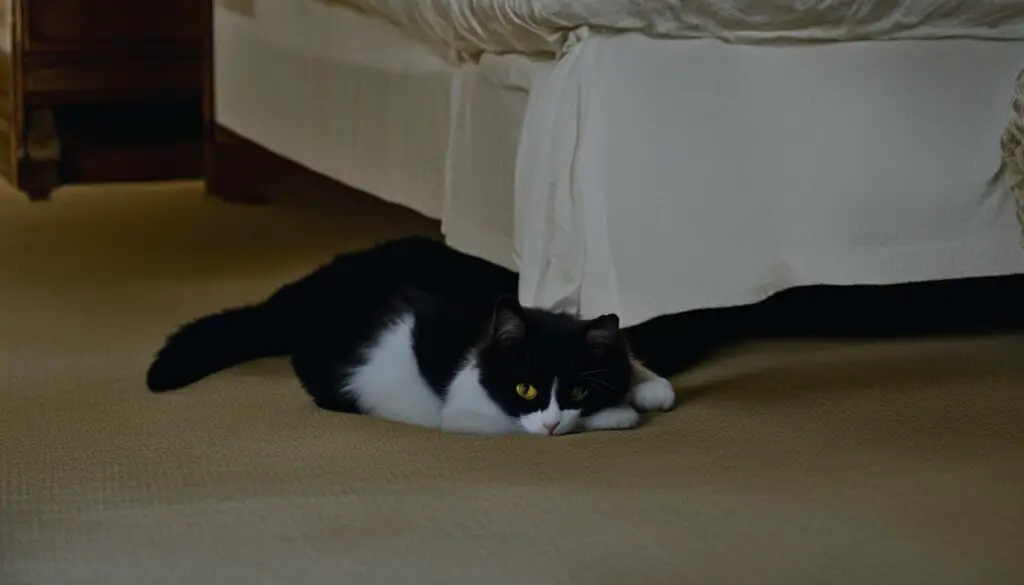
Observing changes in a cat’s hiding behavior is essential. Any noticeable changes or concerns should be addressed promptly. Consulting a veterinarian is recommended to rule out medical issues and determine if the hiding behavior is behavioral or caused by pain or illness. Understanding a cat’s individual preferences for hiding can help create a comfortable environment that meets their needs. Responding with empathy and providing appropriate resources and enrichment activities can support a cat’s mental and physical well-being.
Why Do Cats Hide?
Cats are notorious for their hiding behavior, and there are several reasons why they do so. Understanding these reasons can help cat owners address their feline companions’ needs and ensure their well-being.
- Changes in environment: Cats are creatures of habit, and any changes in their environment can lead to stress and anxiety. This includes moving to a new home, rearranging furniture, or introducing new family members or pets.
- Overstimulation: Cats have sensitive senses, and loud noises, excessive activity, or too much attention can overwhelm them. Seeking out a hiding spot provides them with a quiet place to escape and reduce stimulation.
- Fear: Cats are naturally cautious animals, and they may hide when they perceive a potential threat. This could be a strange noise, a sudden movement, or unfamiliar visitors in the home.
- Discomfort and illness: Cats may hide when they are feeling unwell or in pain. This instinctive behavior allows them to mask any signs of weakness and protect themselves from potential predators.
It’s important for cat owners to be observant of their cats’ hiding behavior and look for any signs of distress or changes in their routines. If a cat’s hiding behavior becomes excessive or is accompanied by other worrisome symptoms, such as loss of appetite or lethargy, it is recommended to consult a veterinarian for a thorough examination. A veterinarian can help rule out any underlying medical conditions and provide appropriate guidance and treatment if needed.
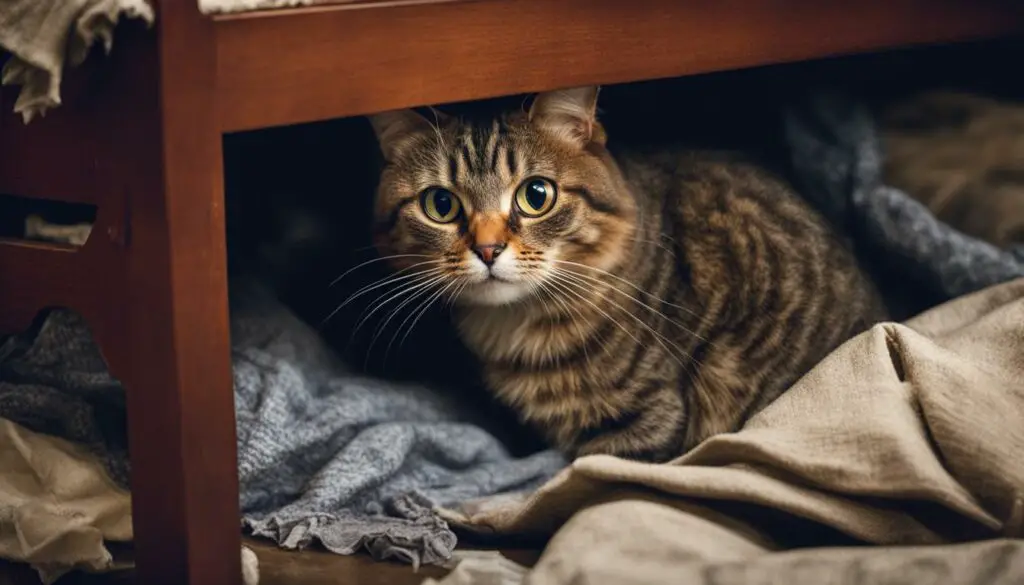
When to Be Concerned
While hiding is a normal behavior for cats, there are certain circumstances where it may be a cause for concern. It is important to pay attention to any changes in a cat’s hiding behavior, as well as any accompanying symptoms or body language cues that may indicate underlying issues. If you notice any of the following concerns, it is recommended to consult a veterinarian for further evaluation:
- Sudden changes in hiding behaviors
- Prolonged periods of hiding
- Hiding accompanied by other symptoms, such as lethargy, loss of appetite, vomiting, or bathroom accidents
- Changes in body language, such as dilated pupils, flattened ears, or a tightly tucked body
These signs may indicate that there is more going on with your cat than just normal hiding behavior. Veterinary consultation can help determine the underlying cause and appropriate course of action to address any potential concerns.
To better understand whether your cat’s hiding behavior is a cause for concern, it is important to observe their overall demeanor and behavior in conjunction with their hiding patterns. By paying close attention to your cat’s actions and seeking professional guidance when needed, you can ensure that your feline companion receives the appropriate care and attention.
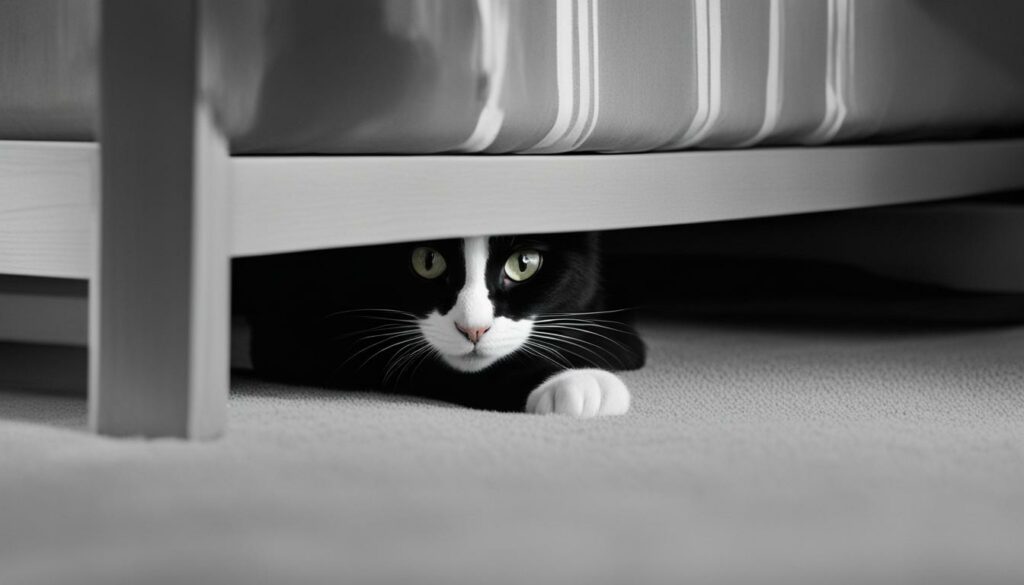
Behavior Changes
“Hiding accompanied by other symptoms, such as lethargy, loss of appetite, vomiting, or bathroom accidents.”
| Behavior Change | Possible Causes |
|---|---|
| Increased hiding | Stress, fear, discomfort, illness |
| Lethargy | Illness, pain, stress |
| Loss of appetite | Illness, dental issues, gastrointestinal problems |
| Vomiting | Illness, dietary issues, hairballs |
| Bathroom accidents | Urinary tract issues, stress, behavioral problems |
It is important to note that these are just potential causes and further evaluation from a veterinarian is necessary to determine the exact reason behind the behavior changes.
What Should You Do?
Addressing a cat’s hiding behavior requires a thoughtful and patient approach. If you notice that your cat is hiding more than usual, it’s important to first rule out any underlying medical issues by consulting a veterinarian. Once medical issues have been addressed, it’s crucial to respect your cat’s need for privacy and allow them to come out of hiding on their own terms. Forcing a cat out of their hiding place can damage trust and cause additional stress.
To help your cat feel safe and secure, provide them with a comfortable hiding spot that is easily accessible. This could be a cozy cat bed in a quiet corner or a designated hiding area with blankets and cushions. Make sure your cat has easy access to essential resources such as food, water, and a litterbox near their hiding spot. In addition, you can use treats and toys as positive reinforcements to encourage your cat to explore their environment and alleviate stress.
It’s important to also consider any changes in the household environment that may be causing stress or discomfort for your cat. This could include loud noises, new family members or pets, or changes in routine. Taking steps to minimize these stressors and create a calm and predictable environment can help reduce your cat’s hiding behavior. Consulting with a veterinarian or a professional cat behaviorist can provide further guidance and support in addressing your cat’s hiding behavior.
| Addressing Hiding Behavior | Helping Cats Feel Safe | Behavior Changes | Consulting a Veterinarian |
|---|---|---|---|
| Rule out any underlying medical issues | Provide a comfortable hiding spot | Use treats and toys as positive reinforcements | Seek professional guidance if needed |
| Respect your cat’s need for privacy | Ensure easy access to essential resources | Address any changes in the household environment | Get professional advice for a holistic approach |
| Allow your cat to come out of hiding on their own | Minimize stressors and create a calm environment | Consult a veterinarian or a cat behaviorist |
How Can ElleVet CBD + CBDA Help Your Cat?
If your cat is experiencing stress, joint discomfort, or you simply want to improve their overall well-being, ElleVet CBD + CBDA can be a beneficial solution. This specially formulated product is designed to help relax stressed cats and support them in adjusting to household changes or overstimulation. The natural compounds in ElleVet CBD + CBDA can also provide relief for cats with joint discomfort, promoting their comfort and mobility.
When it comes to dosing, ElleVet CBD + CBDA products ensure proper administration for cats. The recommended dosage depends on your cat’s size and specific needs, so it’s important to consult a veterinarian to determine the appropriate amount. By following their guidance, you can ensure that your cat receives the optimal dosage for maximum effectiveness.
Furthermore, ElleVet CBD + CBDA products have undergone extensive safety studies in cats, providing reassurance about their use. These studies demonstrate that the products are well-tolerated and safe for cats when used as directed. However, it’s always recommended to consult with a veterinarian before introducing any new products or treatments to your cat’s routine.
| Benefits of ElleVet CBD + CBDA for Cats |
|---|
| Relaxes stressed cats |
| Supports adjustment to household changes or overstimulation |
| Provides relief for cats with joint discomfort |
| Promotes overall well-being |
| Formulated specifically for cats |
| Proper dosing ensures effectiveness |
| Backed by safety studies in cats |
ElleVet CBD + CBDA offers a natural and holistic approach to supporting your cat’s health and well-being. By consulting with a veterinarian and incorporating ElleVet CBD + CBDA into your cat’s routine, you can help them find relief from stress, discomfort, and overall promote a healthier and happier life.
Cats’ Instinctual Need to Hide
Cats have a natural instinct to hide, which can be attributed to both their predator and prey instincts. In the wild, cats hide to stalk and ambush their prey, using hiding spots as a strategic advantage. On the other hand, hiding also serves as a survival tool for cats, helping them avoid predators and stay out of harm’s way. This instinctual behavior is deeply rooted in their DNA and has been passed down through generations.
For cats, hiding provides a sense of security and comfort. It allows them to retreat to a safe space where they can relax, rest, and observe their surroundings without feeling vulnerable. Hiding spots offer cats a cozy and enclosed environment, providing warmth, darkness, and a feeling of being hidden from potential threats. It’s important to understand and respect this instinctual need to hide, as it is a fundamental part of a cat’s natural behavior.
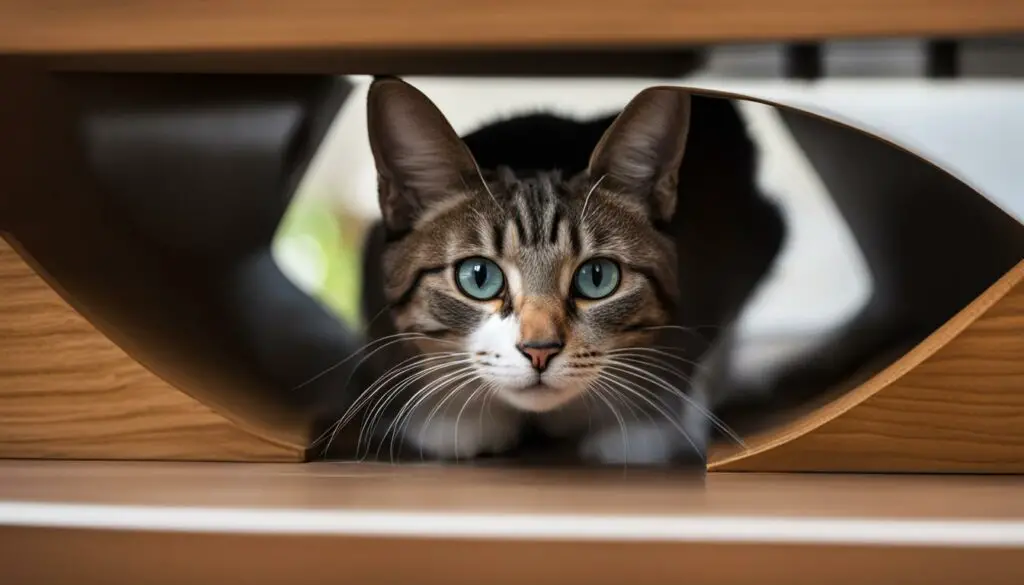
As cat owners, it’s essential to create an environment that supports a cat’s instinctual need to hide. Provide your feline companion with various hiding spots throughout your home, such as cat trees, cardboard boxes, or cozy beds tucked away in quiet corners. These alternative hiding options can give your cat a sense of choice and control over where they choose to seek refuge.
It’s important to note that excessive or sudden changes in hiding behavior can be a cause for concern and may indicate underlying stress, fear, or illness. If you notice significant changes in your cat’s hiding patterns, it’s advisable to consult a veterinarian to rule out any potential medical issues and address any behavioral concerns.
Reasons for Cats to Hide in the Home
When it comes to cats hiding in the home, there can be several reasons behind their behavior. One common reason is fear and anxiety. Cats are naturally cautious animals and may seek solitude in hidden spaces when they feel scared or threatened. Loud noises or the presence of unfamiliar visitors can trigger fear-based hiding.
Another reason cats hide is to adapt to new environments. Whether it’s a new home or the introduction of new family members or pets, cats may use hiding as a way to acclimate to the changes around them. It allows them to feel secure while they adjust to their surroundings.
Hiding can also be a sign that a cat is experiencing illness or pain. Cats instinctively seek out a safe place to recover and hide signs of weakness. If you notice your cat hiding more frequently or for prolonged periods, it’s important to monitor for any additional symptoms that may indicate a health issue.
| Reasons for Cats to Hide in the Home | |
|---|---|
| Fear and Anxiety | Hiding in response to loud noises or unfamiliar visitors |
| Seeking Solitude | Using hiding spots to find privacy and peace |
| Adapting to New Environments | Hiding while adjusting to changes in the home or new family members/pets |
| Illness or Pain | Seeking a safe place to recover and hiding signs of weakness |
How to Address Excessive Hiding Behavior
Excessive hiding behavior in cats can be a cause for concern, but it’s important to approach the issue with understanding and patience. Punishing a cat for hiding can make the situation worse, so it’s crucial to address the root cause of the behavior and provide alternative options.
One way to address excessive hiding is by offering alternative spots for your cat to hide. This can redirect their preference for hiding under the bed and provide them with new hiding options that may be more comfortable or appealing. Cat trees, tunnels, or cozy cat beds placed in strategic locations can create safe and inviting hiding spots.
Positive reinforcement is another effective approach to encourage cats to spend more time in common areas. Use treats, affection, and playtime as rewards when your cat chooses to venture out from their hiding spot. This will help them associate positive experiences with being outside of their hiding place and may gradually reduce their excessive hiding behavior.
Excessive hiding may require intervention. Punishing a cat for hiding can make the situation worse, so it’s important to address the root cause of the behavior.
If your cat’s excessive hiding behavior continues or is accompanied by other concerning behaviors, it’s crucial to consult a veterinarian. They can help determine if there are any underlying medical issues causing the hiding behavior or if there are additional steps you should take to address the problem.
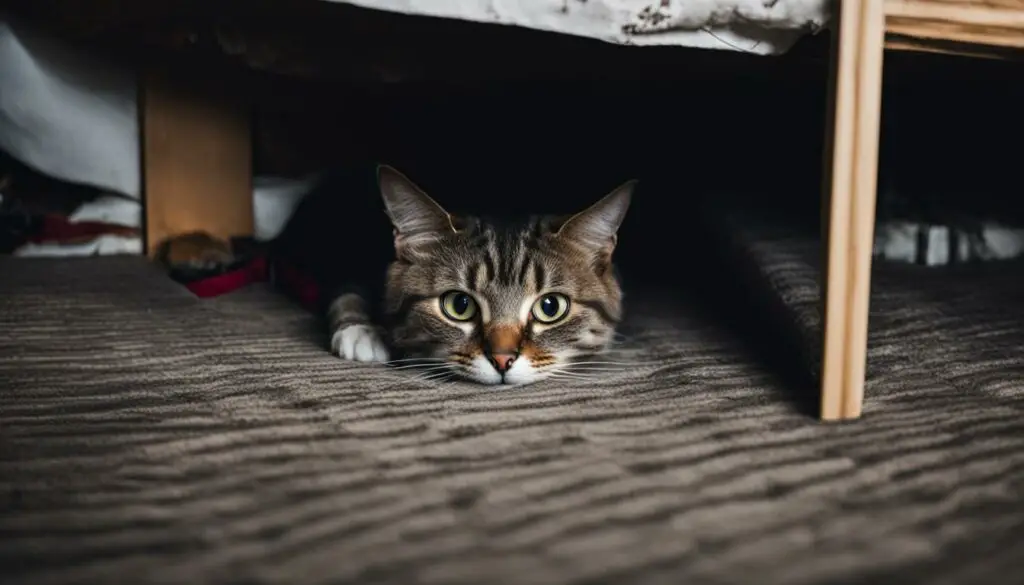
| How to Address Excessive Hiding Behavior | Benefits |
|---|---|
| Offer alternative spots for hiding | Redirects preference for hiding under the bed |
| Use positive reinforcement | Encourages cats to spend more time outside of hiding spots |
| Consult a veterinarian | Identifies underlying medical issues and provides appropriate guidance |
When Hiding Indicates Illness or Pain
Uncharacteristic hiding behavior can be a sign that your cat is experiencing illness or pain. If you notice that your cat is hiding for extended periods of time and is not engaging in regular activities, such as eating or using the litterbox, it is important to schedule a veterinary examination. Other signs to watch for include loss of appetite, vomiting, difficulty walking, constant purring, or avoiding the litterbox. Cats are adept at hiding signs of pain, so it’s crucial to seek medical attention if hiding behavior raises concerns.

If you suspect that your cat is hiding due to illness or pain, it is best to consult a veterinarian for a thorough examination. A vet will be able to assess your cat’s overall health and determine if there are any underlying medical conditions that may be causing the hiding behavior. They may also recommend further diagnostic tests or treatments to address the issue.
Remember, cats are masters at hiding their discomfort, so it’s important to be vigilant and observant of any changes in their behavior. If you notice any uncharacteristic hiding behavior or other concerning symptoms, don’t hesitate to seek professional help. Your cat’s well-being is always a priority, and prompt veterinary attention can help ensure they receive the care they need.
Patterns in Hiding Behavior
Understanding the patterns in a cat’s hiding behavior can provide valuable insights into their needs and preferences. Cats may exhibit seasonal hiding, preferring warm spots during colder months. They may also engage in time-based hiding, choosing to hide during certain parts of the day when they feel more active. Each cat has their own individual preferences for hiding spots, whether it’s a cozy corner, a secluded perch, or a secluded area under the bed.
Seasonal Hiding: Cats are known to seek warmth during colder months, and this can influence their hiding behavior. They may choose to hide in places that provide extra warmth, such as near a heater or a cozy blanket. Observing these patterns can help cat owners create comfortable hiding spots that cater to their cat’s seasonal preferences.
Time-Based Hiding: Cats are naturally more active during dawn and dusk. During other parts of the day, they may choose to hide and rest. Understanding this pattern can help cat owners recognize when their cat may need some quiet time and provide appropriate hiding spots for them to retreat to.
| Patterns in Hiding Behavior | Description |
|---|---|
| Seasonal Hiding | Cats seek warmer hiding spots in colder months |
| Time-Based Hiding | Cats hide during other parts of the day, taking rest periods |
| Individual Preferences | Cats have unique hiding spot preferences based on comfort and security |
Individual Preferences: Just like humans, cats have their own unique preferences when it comes to hiding spots. Some may prefer cozy corners with soft cushions, while others may favor elevated perches that provide a vantage point. Understanding and respecting these individual preferences can help cat owners create a safe and appealing environment that meets their cat’s needs.
By observing and understanding the patterns in a cat’s hiding behavior, cat owners can create a harmonious environment that supports their cat’s comfort and well-being. Providing appropriate hiding spots that cater to seasonal preferences, recognizing the need for quiet time during certain parts of the day, and respecting individual hiding spot preferences can all contribute to a happy and contented feline companion.
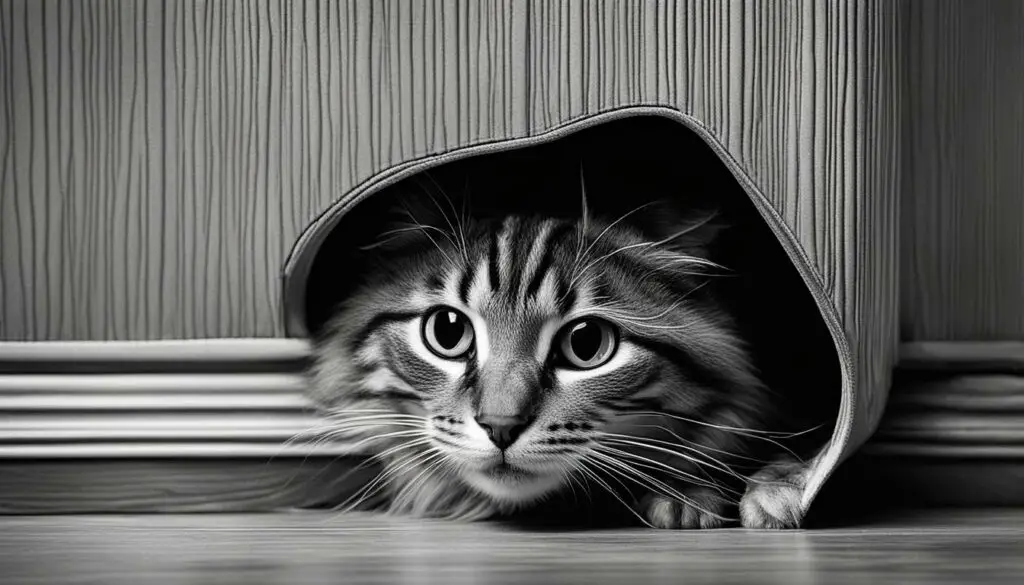
Creating Safe and Fun Hiding Spots
Creating safe hiding spots for our feline friends is crucial to their well-being. While cats naturally seek out hiding places, it’s important to provide them with alternative options and discourage unwanted hiding in certain areas. By doing so, we can protect cats from potential dangers and ensure they feel secure in their environment.
One way to create safe hiding spots is to offer comfortable alternatives. Cat beds placed in cozy corners or elevated shelves can provide cats with their own designated hiding areas. Additionally, providing cardboard boxes with soft blankets can offer a sense of security and warmth. These alternative hiding spots can redirect the cat’s preference away from under the bed and towards these designated areas.
When it comes to discouraging unwanted hiding, there are a few strategies we can employ. If there are certain areas where we don’t want our cats to hide, we can restrict access to those spaces by closing doors or using baby gates. Additionally, we can use scents or textures that cats dislike, such as citrus or double-sided tape, to deter them from those areas.
“Creating safe hiding spots for cats is crucial to their well-being. By offering comfortable alternatives and discouraging unwanted hiding, we can protect our furry friends from potential dangers and ensure they feel secure in their environment.
It’s important to be mindful of potential dangers that cats may encounter while hiding. For example, cats should never be allowed to hide behind dryers or inside appliances, as this can pose serious risks. Ensuring that hiding spots are free from any hazards, such as exposed wires or toxic substances, is essential for the safety of our cats. Regularly inspecting hiding spots and making any necessary modifications can help prevent accidents or injuries.
| Safe Hiding | Unsafe Hiding |
|---|---|
| Cozy cat beds | Behind dryers |
| Cardboard boxes with blankets | Inside appliances |
| Elevated shelves | In cluttered storage areas |
In conclusion, creating safe and fun hiding spots for our cats is an important aspect of their overall well-being. By offering comfortable alternatives, discouraging unwanted hiding, and protecting cats from potential dangers, we can ensure that they feel secure and happy in their environment. Remember to regularly inspect hiding spots for any potential hazards and provide appropriate modifications as needed. With these measures in place, our cats can enjoy their hiding spots while staying safe and protected.

Observing and Responding to Hiding Behavior
When it comes to our feline companions, understanding their behavior is essential in providing them with the care they need. One common behavior that many cats exhibit is hiding, which can be completely normal. However, as responsible cat parents, it is important to observe any changes in their hiding behavior and address any concerns that may arise.
Observing changes in your cat’s hiding behavior can provide valuable insights into their overall well-being. If you notice that your cat is hiding more frequently or for longer periods of time, it may be a sign of underlying issues that need to be addressed. Changes in hiding patterns, such as choosing different spots or avoiding previously favored hiding places, can also indicate potential stress or discomfort.
Addressing any concerns related to your cat’s hiding behavior is crucial. Consulting a veterinarian is recommended in order to rule out any underlying medical conditions that may be causing the change in behavior. Your veterinarian can conduct a thorough examination and provide guidance on how to best support your cat’s well-being.
Understanding your cat’s preferences for hiding can also help create a comfortable environment. Some cats may prefer enclosed spaces, while others may feel more secure in elevated areas. By providing a variety of hiding options, such as cat trees, cozy beds, or even cardboard boxes, you can help your cat feel safe and secure in their hiding spots. Additionally, providing enrichment activities and interactive toys can help alleviate any stress or boredom that may be contributing to their hiding behavior.
| Observing and Responding to Hiding Behavior |
|---|
| Observing changes in hiding behavior |
| Addressing concerns |
| Consulting a veterinarian |
| Understanding cat preferences |
Remember, every cat is unique, and their hiding behavior can vary. By observing changes, addressing concerns, consulting a veterinarian, and understanding your cat’s preferences, you can ensure that your feline friend receives the care and support they need for a happy and healthy life.
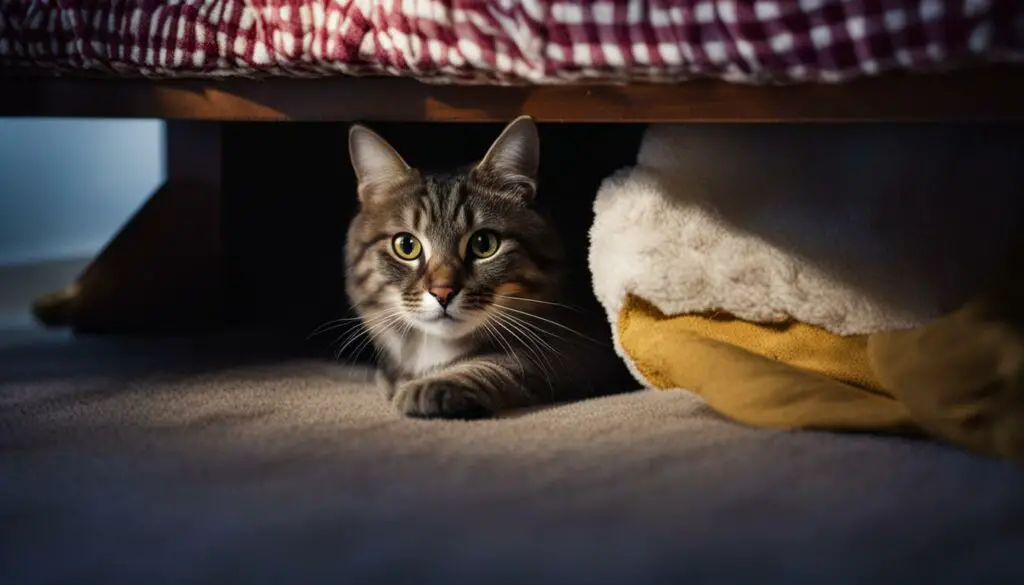
Conclusion
Understanding cat behavior, particularly hiding under the bed, is crucial for cat owners. While cats hiding under the bed is a normal behavior, it’s important to be observant of any changes or concerns. If there are sudden changes in hiding patterns or accompanying symptoms, it’s recommended to consult a veterinarian.
Veterinary guidance is important to rule out any underlying medical issues and determine if the hiding behavior is behavioral or caused by pain or illness. By addressing concerns with professional guidance, cat owners can ensure their furry companions receive the appropriate care and support.
Creating a safe and comfortable environment for cats to hide is essential. Providing alternative hiding options, such as cozy cat beds or cardboard boxes, can redirect their preferences. It’s also important to protect cats from hiding in dangerous places and discourage unwanted hiding spots.
Observing changes in hiding behavior and responding with empathy and proper care is crucial for the overall well-being of cats. By understanding their individual preferences and providing appropriate resources and enrichment activities, cat owners can ensure their cats feel secure and happy in their environment.
FAQ
Is hiding normal for cats?
Yes, hiding is a normal behavior for cats. It provides them with a sense of safety, comfort, and security.
Why do cats hide?
Cats may hide due to changes in their environment, overstimulation, fear, discomfort, or illness.
When should I be concerned about my cat’s hiding behavior?
You should be concerned if there are sudden changes in hiding behaviors, prolonged hiding periods, or hiding accompanied by other concerning symptoms.
What should I do if my cat is hiding more than usual?
First, rule out any underlying medical issues by consulting a veterinarian. Then, provide a comfortable hiding spot and address any changes in the household environment.
How can ElleVet CBD + CBDA help my cat?
ElleVet CBD + CBDA products can help relax stressed cats and provide relief for joint discomfort. They are formulated specifically for cats and have undergone long-term safety studies.
Why do cats have an instinctual need to hide?
Cats have both predator and prey instincts, and hiding is rooted in their survival skills. Hiding provides them with warmth, darkness, and a sense of safety.
Why do cats hide in the home?
Cats may hide in the home due to fear, anxiety, seeking solitude, adapting to new environments, or as a sign of illness or pain.
How can I address excessive hiding behavior in my cat?
Punishing a cat for hiding can make the situation worse. Offer alternative hiding spots, use positive reinforcement, and consult a veterinarian for guidance.
When does hiding indicate illness or pain in cats?
Uncharacteristic hiding behavior, especially when accompanied by other concerning symptoms, can be a sign of illness or pain. Veterinary examination is recommended.
Are there patterns in hiding behavior?
Cats may exhibit patterns in their hiding behavior influenced by seasonal factors, home environment, and individual preferences.
How can I create safe and fun hiding spots for my cat?
Offer cat beds, cardboard boxes, or other cozy options. Deter unwanted hiding spots and protect cats from dangerous areas.
How should I observe and respond to my cat’s hiding behavior?
Be observant of changes, address concerns promptly, consult a veterinarian, and create an environment that meets your cat’s needs.
What’s the importance of understanding cat behavior and addressing concerns?
Understanding cat behavior and addressing concerns promptly with veterinary guidance contribute to the overall well-being of cats.

